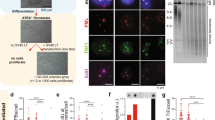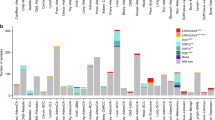Abstract
Epithelial cancers of the elderly are caused by a combination of telomere dysfunction and the mutational invalidation of major tumor suppressors including p53. A recent article published in Cell by Davoli et al. shows that the simultaneous elimination of p53 and telomerase causes a state of chronic DNA damage that results in tetraploidization through endoreplication, that is, two consecutive S phases that are not separated by mitosis. As tetraploid cells represent a metastable intermediate between normal diploidy and cancer-associated aneuploidy, this novel route to tetraploidization may constitute (one of) the functional link(s) between aging and carcinogenesis.
This is a preview of subscription content, access via your institution
Access options
Subscribe to this journal
Receive 50 print issues and online access
$259.00 per year
only $5.18 per issue
Buy this article
- Purchase on Springer Link
- Instant access to full article PDF
Prices may be subject to local taxes which are calculated during checkout

Similar content being viewed by others
References
Artandi SE, Chang S, Lee SL, Alson S, Gottlieb GJ, Chin L et al. (2000). Telomere dysfunction promotes non-reciprocal translocations and epithelial cancers in mice. Nature 406: 641–645.
Blasco MA, Lee HW, Hande MP, Samper E, Lansdorp PM, DePinho RA et al. (1997). Telomere shortening and tumor formation by mouse lacking telomerase RNA. Cell 91: 25–34.
Castedo M, Coquelle A, Vivet S, Vitale I, Kauffmann A, Dessen P et al. (2006). Apoptosis regulation in tetraploid cancer cells. EMBO J 25: 2584–2595.
Castedo M, Ferri KF, Blanco J, Roumier T, Larochette N, Barretina J et al. (2001). Human immunodeficiency virus 1 envelope glycoprotein complex-induced apoptosis involves mammalian target of rapamycin/FKBP12-rapamycin-associated protein-mediated p53 phosphorylation. J Exp Med 194: 1097–1110.
Danes BS . (1978). Increased in vitro tetraploidy: tissue specific within the heritable colorectal cancer syndromes with polyposis coli. Cancer 41: 2330–2334.
Davoli T, Denchi EL, de Lange T . (2010). Persistent telomere damage induces bypass of mitosis and tetraploidy. Cell 141: 81–93.
Duelli DM, Padilla-Nash HM, Berman D, Murphy KM, Ried T, Lazebnik Y . (2007). A virus causes cancer by inducing massive chromosomal instability through cell fusion. Curr Biol 17: 431–437.
Dutrillaux B, Gerbault-Seureau M, Remvikos Y, Zafrani B, Prieur M . (1991). Breast cancer genetic evolution: I. Data from cytogenetics and DNA content. Breast Cancer Res Treat 19: 245–255.
Engelhardt M, Albanell J, Drullinsky P, Han W, Guillem J, Scher HI et al. (1997). Relative contribution of normal and neoplastic cells determines telomerase activity and telomere length in primary cancers of the prostate, colon, and sarcoma. Clin Cancer Res 3: 1849–1857.
Finley JC, Reid BJ, Odze RD, Sanchez CA, Galipeau P, Li X et al. (2006). Chromosomal instability in Barrett's esophagus is related to telomere shortening. Cancer Epidemiol Biomarkers Prev 15: 1451–1457.
Ganem NJ, Pellman D . (2007). Limiting the proliferation of polyploid cells. Cell 131: 437–440.
Halazonetis TD, Gorgoulis VG, Bartek J . (2008). An oncogene-induced DNA damage model for cancer development. Science 319: 1352–1355.
Jackson SP, Bartek J . (2009). The DNA-damage response in human biology and disease. Nature 461: 1071–1078.
Kwon M, Godinho SA, Chandhok NS, Ganem NJ, Azioune A, Thery M et al. (2008). Mechanisms to suppress multipolar divisions in cancer cells with extra centrosomes. Genes Dev 22: 2189–2203.
Lantuejoul S, Soria JC, Morat L, Lorimier P, Moro-Sibilot D, Sabatier L et al. (2005). Telomere shortening and telomerase reverse transcriptase expression in preinvasive bronchial lesions. Clin Cancer Res 11: 2074–2082.
Margolis RL . (2005). Tetraploidy and tumor development. Cancer Cell 8: 353–354.
Maruyama Y, Hanai H, Fujita M, Kaneko E . (1997). Telomere length and telomerase activity in carcinogenesis of the stomach. Jpn J Clin Oncol 27: 216–220.
Meeker AK, Hicks JL, Iacobuzio-Donahue CA, Montgomery EA, Westra WH, Chan TY et al. (2004). Telomere length abnormalities occur early in the initiation of epithelial carcinogenesis. Clin Cancer Res 10: 3317–3326.
Olaharski AJ, Sotelo R, Solorza-Luna G, Gonsebatt ME, Guzman P, Mohar A et al. (2006). Tetraploidy and chromosomal instability are early events during cervical carcinogenesis. Carcinogenesis 27: 337–343.
Rello-Varona S, Vitale I, Kepp O, Senovilla L, Jemaa M, Metivier D et al. (2009). Preferential killing of tetraploid tumor cells by targeting the mitotic kinesin Eg5. Cell Cycle 8: 1030–1035.
Roumier T, Valent A, Perfettini JL, Metivier D, Castedo M, Kroemer G . (2005). A cellular machine generating apoptosis-prone aneuploid cells. Cell Death Differ 12: 91–93.
Sahin E, Depinho RA . (2010). Linking functional decline of telomeres, mitochondria and stem cells during ageing. Nature 464: 520–528.
Senovilla L, Vitale I, Galluzzi L, Vivet S, Joza N, Younes AB et al. (2009). p53 represses the polyploidization of primary mammary epithelial cells by activating apoptosis. Cell Cycle 8: 1380–1385.
Skyldberg BM, Murray E, Lambkin H, Kelehan P, Auer GU . (1999). Adenocarcinoma of the uterine cervix in Ireland and Sweden: human papillomavirus infection and biologic alterations. Mod Pathol 12: 675–682.
Vitale I, Senovilla L, Jemaa M, Michaud M, Galluzzi L, Kepp O et al. (2010). Multipolar mitosis of tetraploid cells: inhibition by p53 and dependency on Mos. EMBO J 29: 1272–1284.
Acknowledgements
GK was supported by the Ligue Nationale contre le Cancer (Equipes labellisée), Agence Nationale pour la Recherche (ANR), European Commission (Active p53, Apo-Sys, Chemo Res, ApopTrain), Fondation pour la Recherche Médicale (FRM), Institut National du Cancer (INCa) and Cancéropôle Ile-de-France. IV was supported by the Ligue Nationale contre le Cancer.
Author information
Authors and Affiliations
Corresponding authors
Ethics declarations
Competing interests
The authors declare no conflict of interest.
Rights and permissions
About this article
Cite this article
Castedo, M., Vitale, I. & Kroemer, G. A novel source of tetraploid cancer cell precursors: telomere insufficiency links aging to oncogenesis. Oncogene 29, 5869–5872 (2010). https://doi.org/10.1038/onc.2010.392
Received:
Revised:
Accepted:
Published:
Issue Date:
DOI: https://doi.org/10.1038/onc.2010.392



